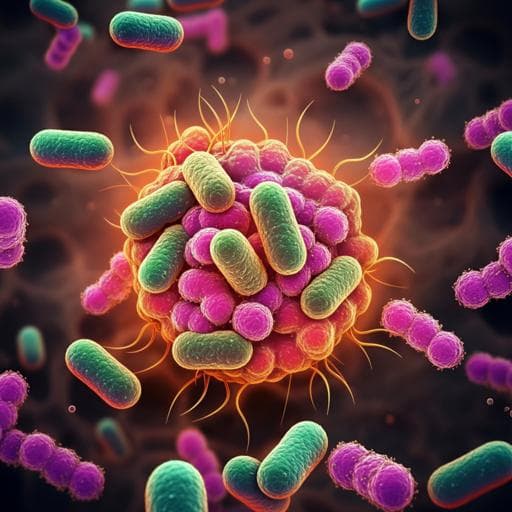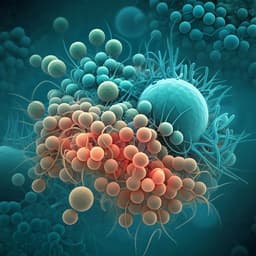
Veterinary Science
Effects of dietary organic acids and nature identical compounds on growth, immune parameters and gut microbiota of European sea bass
S. Busti, B. Rossi, et al.
In a recent 71-day study by Serena Busti and colleagues, the effects of dietary levels of microencapsulated organic acids were explored on European sea bass juveniles. While growth wasn't enhanced, significant increases in immune gene expression were observed, together with beneficial shifts in gut microbiota, even under challenging conditions. Discover how these findings could impact aquaculture!
~3 min • Beginner • English
Introduction
Organic acids are widely used in terrestrial livestock to improve performance and health but their application in aquaculture is comparatively recent. As functional additives, organic acids can enhance feed hygiene, modulate gastrointestinal pH and enzyme activity, influence gut microbiota, and reinforce health. Citric acid has improved growth and feed utilisation in several fish and crustacean species, while sorbic acid exhibits strong antimicrobial activity. Botanicals and nature identical compounds such as thymol and vanillin have shown antimicrobial and anti-inflammatory properties and can enhance palatability and immunity in fish. Blends of organic acids and NICs may provide synergistic effects, and microencapsulation can target release to the intestine. However, their combined use has not been tested in marine fish species like European sea bass. This study aimed to: (1) evaluate the effects of increasing dietary levels of a microencapsulated blend of citric acid, sorbic acid, thymol and vanillin on growth, feed utilisation, intestinal cytokine gene expression and gut microbiota of European sea bass; and (2) assess the effects of this blend on intestinal cytokine gene expression and gut microbiota under suboptimal rearing conditions (high temperature and low dissolved oxygen).
Literature Review
Prior work in pigs and poultry has established benefits of organic acids for performance and health. In aquaculture, citric acid supplementation has improved growth, SGR and FCR in species including red drum, rainbow trout, beluga sturgeon, yellowtail, tilapia and red sea bream. Sorbic acid acts antimicrobially at neutral pH by inhibiting bacterial enzymes and nutrient transport. Botanicals/NICs (e.g., thymol, vanillin) have demonstrated growth-promoting, antimicrobial and anti-inflammatory effects in mammals and have been explored in fish to improve palatability, immunity and pathogen control. Blends of OA and NIC, especially when microencapsulated, displayed positive effects on performance, microbiome modulation and health in terrestrial livestock, and in Pacific white shrimp and rainbow trout. Nonetheless, combined OA+NIC supplementation had not been evaluated in marine fish, and interactions with environmental stressors (temperature, hypoxia) on gut microbiota and immunity remain underexplored in sea bass.
Methodology
Design: A 71-day feeding trial with European sea bass juveniles tested four dietary inclusion levels of a microencapsulated blend of organic acids and nature identical compounds: 0 (D0), 250 (D250), 500 (D500), and 1000 (D1000) mg kg⁻¹ feed. The blend provided 25% citric acid, 16.7% sorbic acid, 1.7% thymol, and 1% vanillin in a hydrogenated fat matrix. The base commercial diet (49.8% protein; 20.6% lipid; energy 5152.6 cal/g) was coated with the blend.
Fish and rearing: 60 fish per tank (initial BW ≈ 13.23 ± 0.18 g) were randomly allocated to twelve 500 L tanks (triplicates per diet) in a recirculating seawater system (temperature 23 ± 1 °C; salinity 25 g L⁻¹; oxygen 8.0 ± 1.0 mg L⁻¹). Fish were hand-fed to apparent satiation twice daily (once on Sundays) for 71 days.
Suboptimal rearing challenge: After day 71, fish from D0 and D1000 were exposed for 8 days to high temperature (30.0 ± 0.4 °C) and low dissolved oxygen (4.6 ± 0.6 mg L⁻¹). Temperature was raised at 2 °C day⁻¹; oxygen was reduced from ~8.0 to ~4.6 mg L⁻¹ within 24 h and then maintained.
Sampling and measurements: Growth (BW, SGR), feed intake (FI), feed conversion ratio (FCR) were recorded at day 37 and day 71. Biometric indices (VSI, HSI, CF) and whole-body proximate composition were measured at trial end. Nutritional indices (PER, GPE, LER, GLE) were calculated.
Immune gene expression: Distal intestinal mucosa was sampled at baseline, day 71 (T1), and post-challenge (T2). Total RNA was extracted; cDNA synthesized; RT-qPCR quantified IL-1β, IL-6, IL-8, IL-10, TNF-α, and TGF-β, normalized to β-actin, using 2⁻ΔΔCt.
Gut microbiota: Distal intestinal contents (5 fish per tank) were collected at day 71 and post-challenge (pooled per tank post-challenge due to low content). DNA was extracted; 16S rRNA V3–V4 region was amplified (primers 341F/785R) and sequenced on Illumina MiSeq (2×250 bp). Sequences (1,857,956 high-quality reads) were processed with PANDAseq and QIIME; OTUs clustered at 97% (UCLUST); taxonomy assigned via RDP/Greengenes (May 2013). Alpha diversity (Shannon, observed species) and PCA (Euclidean distance) assessed community structure. PICRUSt predicted functional profiles.
Statistics: Linear regression tested dose effects at day 71. Two-way ANOVA (diet × time) assessed cytokine expression for D0 vs D1000 at T1 and T2, with Tukey post hoc where applicable. Microbiota: Wilcoxon rank-sum for alpha diversity and functional count comparisons; PERMANOVA (Adonis) on Euclidean distances for PCA separation. P values were FDR-corrected where appropriate; significance at P ≤ 0.05. Ethical approval per EU Directive 2010/63/EU.
Key Findings
- Growth and feed utilisation: No significant dose effects on FBW, SGR, FI, FCR, or survival across D0, D250, D500, D1000 over 71 days or in sub-intervals (P > 0.05). Survival was 100% in all groups. Representative means over day 0–71: FBW ≈ 56–57 g; SGR ≈ 2.02–2.06% d⁻¹; FI ≈ 18.1–18.5 g kg ABW⁻¹ d⁻¹; FCR ≈ 1.02–1.05.
- Biometric and body composition: VSI, HSI, CF, whole-body protein, lipid, ash, moisture, and nutritional indices (PER, GPE, LER, GLE) showed no significant differences among diets (P > 0.05).
- Immune gene expression at T1 (dose response): Significant dose-dependent upregulation with increasing OA+NIC for IL-8 (P = 0.0288), IL-10 (P = 0.035), and TGF-β (P = 0.00313). IL-1β, IL-6, TNF-α showed no significant linear trends (P > 0.05).
- Immune response to suboptimal conditions (D0 vs D1000; T1 vs T2): Significant time effects indicating inflammation after suboptimal exposure: IL-1β (P = 0.0003), IL-6 (P < 0.0001), IL-8 (P < 0.0001), TNF-α (P = 0.0200), TGF-β (time effect P = 0.0112; diet × time interaction P = 0.0151). In D0, IL-1β, IL-6, IL-8 were upregulated at T2; in D1000, IL-6, IL-8 were upregulated while TGF-β was downregulated at T2.
- Gut microbiota at T1: Dominant phyla were Firmicutes, Actinobacteria, Cyanobacteria. Dominant genera included Lactobacillus, unclassified Leuconostocaceae, and Streptococcus. PCA of Euclidean distances showed significant separation among diets (P = 0.03). Alpha diversity tended to decrease from D0 to D500 and increase at D1000 (not significant). PICRUSt-based PCA also separated groups (P = 0.04). D1000 showed reduced predicted functions: bacterial invasion of epithelial cells (D0: 588 counts vs D1000: 399 ± 14; P = 0.01), bacterial toxins (D0: 7610 vs D1000: 7278 ± 239; P = 0.01), mineral absorption (D0: 1891 vs D1000: 1435 ± 46; P = 0.02).
- Gut microbiota after suboptimal conditions: At phylum level, Firmicutes, Proteobacteria, Bacteroidetes, Actinobacteria, Fusobacteria dominated in both D0 and D1000. LAB markedly decreased: Lactobacillus from 24.2 ± 1.5% to 0.6 ± 0.2%; Leuconostocaceae from 13.4 ± 1.4% to 0.1 ± 0.0%; Streptococcus from 14.8 ± 2.2% to 0.5 ± 0.2%. Proteobacteria increased from 5.5 ± 0.7% to 15.9 ± 3.4%, mainly Enterobacteriaceae (0.1 ± 0.04% to 9.9 ± 2.2%). Bacillus sp. remained relatively stable (5.2 ± 3.1% to 4.6 ± 1.2%). Alpha diversity significantly increased post-challenge for both diets (P = 0.01), with D1000 maintaining diversity comparable to its pre-challenge baseline.
Discussion
The microencapsulated OA+NIC blend did not affect growth or feed utilisation under the conditions and inclusion levels tested, consistent with several prior studies where OA/NIC primarily modulated health rather than promoted growth. The microencapsulation targets intestinal release, suggesting effects are not mediated by gastric acidification. Despite no performance changes, the blend modulated intestinal immune gene expression, with dose-dependent upregulation of anti-inflammatory cytokines IL-10 and TGF-β, and chemokine IL-8, indicating enhanced anti-inflammatory tone and potential reinforcement of epithelial integrity. Under suboptimal rearing conditions (high temperature, low oxygen), pro-inflammatory cytokines were upregulated and TGF-β decreased, demonstrating an induced intestinal inflammatory state. The OA+NIC diet exhibited immune-modulatory effects across time points, suggesting potential resilience benefits.
Gut microbiota profiling indicated that sea bass gut communities are dominated by LAB (Lactobacillus, Leuconostocaceae, Streptococcus), associated with healthy states. While specific taxa changes were not statistically significant after multiple-testing correction, beta-diversity separated by diet, and PICRUSt suggested functional reconfiguration with reduced predicted pathogenicity-related functions in D1000. Slight increases in beneficial taxa (Lactobacillus, Leuconostoc, Bacillus) with OA+NIC are compatible with prebiotic-like effects reported in other fish species. Suboptimal rearing conditions caused marked shifts: reductions in LAB and increases in Proteobacteria, especially Enterobacteriaceae, patterns often linked to environmental stress and potential dysbiosis. Bacillus remained stable, consistent with tolerance to extreme conditions. The D1000 diet appeared to mitigate diversity perturbations post-stress, maintaining diversity closer to baseline.
Conclusion
Dietary inclusion (0–1000 mg kg⁻¹) of a microencapsulated blend of citric acid, sorbic acid, thymol, and vanillin did not enhance growth or feed efficiency in European sea bass juveniles under normal conditions. However, it modulated intestinal immunity by upregulating IL-8, IL-10, and TGF-β and induced a functional reconfiguration of the gut microbiome with reductions in predicted inflammation-related functions. The blend exhibited prebiotic-like properties, tending to support beneficial taxa such as Lactobacillus, Leuconostoc, and Bacillus. Suboptimal rearing conditions (high temperature and low oxygen) reshaped the gut microbiota, reducing LAB and increasing Proteobacteria (notably Enterobacteriaceae) and elicited an inflammatory gene expression profile. The OA+NIC supplementation mitigated some microbiome diversity changes under stress. Future research should test higher inclusion levels, broader dose ranges, additional stress models, and mechanistic links between microbiome changes, immune modulation, and host performance.
Limitations
- The suboptimal rearing challenge was applied only to D0 and D1000 groups, limiting dose–response interpretation under stress.
- Post-challenge gut content samples were pooled per tank due to low individual biomass, reducing resolution of inter-individual variability.
- Despite significant beta-diversity and functional predictions, no specific taxa differences reached significance after FDR correction at T1, which may reflect sample size or effect size limitations.
- Only one microencapsulated formulation and a limited inclusion range (0–1000 mg kg⁻¹) were tested; higher doses or different ratios may yield different outcomes.
- Results are specific to the diet matrix, life stage, and rearing conditions used and may not generalize to other contexts or species.
Related Publications
Explore these studies to deepen your understanding of the subject.







